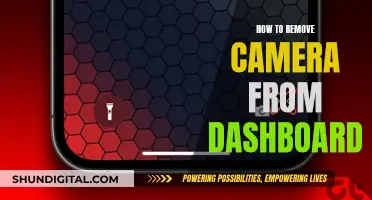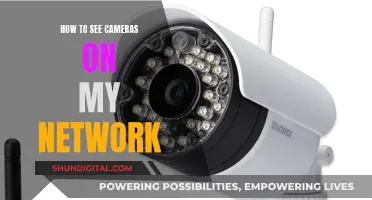
An interlock camera is a small camera mounted on the windshield of a vehicle that is often required alongside an interlock device, which is a gadget installed in vehicles to prevent drunk driving. The camera is designed to capture images of the person using the ignition interlock device, verifying their identity and ensuring they are not drinking and driving. While some people may be curious about how to remove an interlock camera, it is important to understand that doing so without permission can result in legal consequences. In this article, we will discuss the purpose of interlock cameras, the potential consequences of removing them, and provide insights into the legal and safe removal process.
| Characteristics | Values |
|---|---|
| Purpose | To document the identity of the person using the ignition interlock device |
| Installation | Installed by trained technicians |
| Location | Mounted on the windshield |
| Function | Captures images of the person required to use an ignition interlock device |
| Storage | Stores captured images |
| Supply | Supplies images to monitoring authorities as needed |
| Activation | Activated when the driver uses the ignition interlock device |
| Violation | Moving the camera could be a reportable violation |
| Image Use | Proves who is testing their breath alcohol |
| Image Capture | Captures images of the individual taking the test |
| Image Access | Monitoring authorities access images as needed |
| Image Requirements | Clear photo of the user required for compliance with state law |
| Removal | Requires specific process handled by authorized technicians |
What You'll Learn

Understand your legal situation
Understanding your legal situation is crucial if you have an interlock camera installed in your vehicle. Here are some key points to consider:
Varying State Laws
It's important to recognize that laws regarding the use of interlock devices and cameras differ across states. Some states mandate the use of interlock cameras for individuals arrested for drunk driving and seeking to regain driving privileges. Other states leave this decision to the court or probation officer. It's essential to familiarize yourself with the specific requirements and regulations in your state.
Purpose of the Interlock Camera
The primary purpose of the interlock camera is to document the identity of the person using the ignition interlock device. This ensures that the driver cannot tamper with the device or have someone else take the breath alcohol test on their behalf. The camera captures images when the driver provides a breath sample for testing and does not take random photos or videos when the device is not in use.
Implications of Violations
Any violations or test failures are recorded, and even if the offender was not driving at the time of the failed sample, it will still count as a violation. This can result in an extended interlock term or further penalties, depending on state laws and the specifics of your legal situation. It's important to understand that even if others use the vehicle and fail the test, you are ultimately responsible for any violations as the owner of the vehicle.
Privacy Concerns
While interlock cameras do not continuously monitor or record your activities, some individuals may still have privacy concerns. It's important to know that blocking or moving the camera is considered tampering and can result in legal consequences. However, you can rest assured that the camera is not actively recording or transmitting information when the device is not in use.
Seeking Legal Advice
If you have specific questions or concerns about your legal situation, it's always best to consult with an attorney. They can provide personalized guidance based on your unique circumstances and help you navigate any legal complexities or court orders related to your interlock camera requirements. Remember that understanding and complying with the laws in your state is crucial to maintaining your driving privileges and avoiding further legal repercussions.
Capturing Joy: My Smile for the Camera
You may want to see also

Consult a professional
If you are considering removing an interlock camera, it is important to consult a professional to ensure you follow the correct legal process and avoid any potential issues. Here are some detailed instructions on why and how to consult a professional:
Understand the Legal Implications:
Removing an interlock device without proper authorisation can lead to serious legal consequences. Laws and regulations regarding interlock devices vary by state and county, so it is crucial to understand your specific legal situation. Consult an attorney or legal professional to guide you through the process and ensure you comply with all relevant laws and regulations. They can advise you on the specific requirements, forms, and procedures necessary for removing the device legally.
Engage Trained Technicians:
The installation and removal of interlock devices require specialised training. Trained technicians have the necessary skills to safely disconnect the device from your vehicle's ignition system. They can ensure the proper removal of the device, mouthpiece, and handset, as well as uninstall any associated software or apps. By using trained technicians, you can minimise the risk of damage to your vehicle and avoid tampering alerts being sent to authorities or service providers.
Follow the Correct Removal Process:
Each state has different laws and procedures for removing interlock devices. Consult a professional to understand the specific requirements and steps for removal in your state. They can guide you through the correct removal process, including any necessary appointments, forms, and fees. For example, you may need to schedule a de-installation appointment with your interlock provider and pay any associated fees.
Address Post-Removal Considerations:
After removing the interlock device, it is important to inspect your vehicle for any damages or issues caused during the removal process. A professional can help you identify and address any potential problems that may arise. They can also advise you on the possibility of needing to reinstall the device for legal or other reasons. Additionally, they can provide guidance on the time involved in the removal process, which can vary depending on the device and its installation.
Contact the Agency or Company:
Before attempting any removal, it is wise to consult the agency or company that provided the interlock device. They have the most knowledge about the specific device and its removal process. They can provide you with detailed instructions, answer any questions, and ensure that you have completed all the necessary requirements for removal. By working closely with them, you can avoid any potential issues or complications.
The Science Behind Pinhole Cameras and Image Formation
You may want to see also

Disconnect the device
Disconnecting an interlock camera and its related device is a complex process that should be approached with caution. It is important to understand that attempting to remove an interlock device without permission can result in significant legal consequences. Therefore, it is always advisable to consult with a professional or the agency that provided the device before attempting any removal.
That being said, here is a step-by-step guide on how to disconnect the device:
Locate the Device: Find the exact location of the interlock device in your car's ignition system. This may vary depending on the type of device and the make and model of your vehicle. It is important to carefully examine the placement of the device and its connections to the ignition system.
Secure the Device: After disconnecting the device, it is important to secure it properly. This may involve storing it in a safe location or disposing of it according to local regulations. Some devices may need to be returned to the provider, while others may be discarded as electronic waste. It is important to follow the appropriate guidelines for your specific device.
Remove the Mouthpiece and Handset: The mouthpiece and handset are the parts of the device that you blow into for breath alcohol testing. These components can usually be removed by unscrewing or detaching them from the main unit. Make sure to handle them carefully and set them aside for proper disposal or storage.
Uninstall Software or Apps: If your interlock device had any associated software or apps on your phone, be sure to uninstall them. This step ensures that you no longer have any active connections to the device and that all related data is removed from your personal devices.
Check Your Vehicle: After disconnecting and removing the interlock device, it is important to verify that your vehicle still functions properly. Start your car and ensure that the ignition, horn, windshield wipers, and other systems are working correctly. This step helps confirm that the removal process was successful and hasn't caused any unintended issues with your vehicle's operation.
It is important to note that removing an interlock device may result in legal consequences if not done in accordance with local laws and regulations. Always consult with a legal professional or the relevant authorities before attempting to remove an interlock camera and its associated device.
School Bus Camera Footage: Who's Watching?
You may want to see also

Remove the mouthpiece and handset
To remove the mouthpiece and handset, you will need to follow a few simple steps. Firstly, try to grip the mouthpiece with your hand and give it a gentle counter-clockwise twist while pulling it out. If it is not stuck firmly, it should come out easily. If not, you can try a few other methods to dislodge it.
One method is to use a wooden mallet to gently tap the mouthpipe (the insertion point where the mouthpiece goes in). This may help loosen the connection between the mouthpiece and the instrument. Alternatively, you can try tying a loop of rope around the mouthpiece and giving it a yank to see if that dislodges it. If the mouthpiece pops out, be careful that it doesn't fly across the room and get damaged.
If these methods don't work, you can try using a combination of hot and cold water to loosen the mouthpiece. Place your instrument over a sink and tie some ice cubes to the mouthpiece with a wide rubber band, so that they touch the insertion point. Let the ice cubes sit for a few minutes to cool the metal. Then, start running very hot water over the mouthpipe, being careful not to get it on the lacquered part of the lead pipe as this may cause damage. Keep the hot water running for a few minutes, then turn it off and try pulling the mouthpiece out again.
If you're still having trouble, you may need to use a mouthpiece puller, which you can buy or borrow from a music store or band director. Place your instrument on a table, then align the mouthpiece puller on the mouthpiece, following the manufacturer's instructions. Tighten the screws or handle on the puller, then gently twist and pull the mouthpiece to remove it.
Finally, once the mouthpiece is removed, be sure to inspect it for any damage, such as rust, dents, or an oval or squashed shape. If there is any damage, use a mouthpiece trueing tool to return it to its correct shape.
Panasonic TV Camera: Fact or Fiction?
You may want to see also

Uninstall software or apps
If you have an interlock device, it's essential to understand that removing it without permission can get you into legal trouble. If you are thinking of removing your interlock device, it is always best to consult an attorney or a trained technician. They can guide you through the correct process and help you avoid any legal issues.
That being said, if you are looking to uninstall any software or apps related to your interlock device, here are some detailed steps to follow:
Firstly, identify any apps on your phone that are associated with the interlock device. These could be apps that you installed for monitoring, reporting, or interacting with the device. It is important to note that uninstalling these apps may trigger alerts or notifications to the relevant authorities or service providers, so proceed with caution.
Once you have identified the apps, follow the standard procedure for uninstalling apps on your phone. This process will vary depending on the type of phone you have. For example, on an iPhone, you would typically press and hold the app icon until it starts to jiggle, and then tap the "X" in the upper left corner of the app icon to delete it. On an Android phone, you would go to the Settings menu, select "Apps" or "Applications," find the app you want to uninstall, and then tap "Uninstall."
After uninstalling the apps, it is a good idea to restart your phone to ensure that any associated processes are also terminated. Again, be aware that uninstalling these apps may result in notifications being sent to the relevant authorities or service providers.
It is important to emphasize that tampering with or removing an interlock device without proper authorization can lead to severe consequences. These consequences may include legal penalties, fines, or the loss of driving privileges. Therefore, it is always best to consult with a professional or the agency that provided the device before taking any action.
Additionally, keep in mind that interlock devices are often connected to your car's starter and may also be linked to other systems such as your car horn and windshield wipers. As such, it is highly recommended to have trained technicians handle the removal process to avoid any potential damage to your vehicle.
Eradicate Background Noise for Perfect Camera Clarity
You may want to see also
Frequently asked questions
An interlock camera is a camera equipped with an ignition interlock device that is installed in vehicles to prevent drunk driving. The camera is usually mounted on the windshield and captures images of the person using the ignition interlock device.
Interlock cameras are required by law in some states for individuals with a history of drunk driving. The camera helps to document the identity of the person using the ignition interlock device and ensures that they are not drinking and driving.
Removing an interlock camera without proper authorization can result in legal consequences. It is recommended to consult with a lawyer or a professional technician to understand the correct process for removing the camera and complying with any legal requirements.







